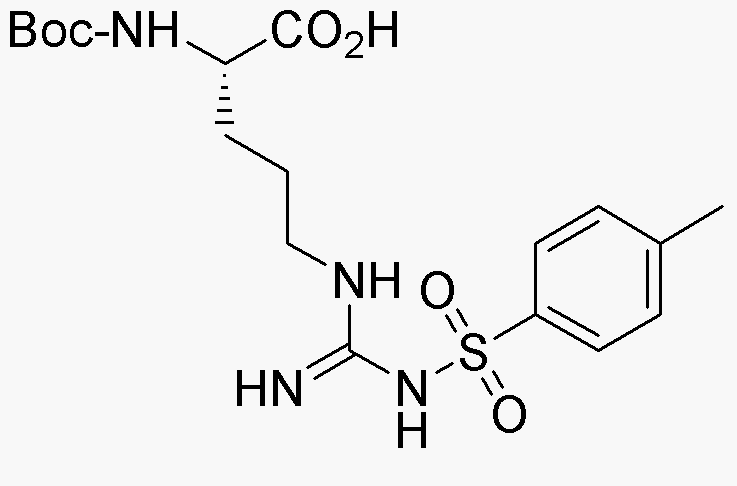Na-Boc-Nw-4-toluenesulfonyl-L-arginine is widely utilized in research focused on:
- Peptide Synthesis: This compound serves as a protecting group in the synthesis of peptides, allowing for selective reactions without interference from other functional groups. This is particularly beneficial in the pharmaceutical industry for creating complex peptide-based drugs.
- Bioconjugation: It is used in bioconjugation processes, where biomolecules are linked to other molecules, enhancing the development of targeted drug delivery systems. This application is crucial in the field of biotechnology and personalized medicine.
- Enzyme Inhibition Studies: Researchers utilize this compound to study enzyme inhibition mechanisms, providing insights into metabolic pathways and potential therapeutic targets, which is vital for drug discovery.
- Diagnostic Reagents: The compound can be employed as a reagent in diagnostic tests, particularly in assays that require specific binding interactions, thus improving the accuracy of medical diagnostics.
- Research on Protein Interactions: It aids in the investigation of protein-protein interactions, helping scientists understand cellular processes and disease mechanisms, which is essential for developing new therapeutic strategies.
Información general
Propiedades
Seguridad y normativas
Aplicaciones
Na-Boc-Nw-4-toluenesulfonyl-L-arginine is widely utilized in research focused on:
- Peptide Synthesis: This compound serves as a protecting group in the synthesis of peptides, allowing for selective reactions without interference from other functional groups. This is particularly beneficial in the pharmaceutical industry for creating complex peptide-based drugs.
- Bioconjugation: It is used in bioconjugation processes, where biomolecules are linked to other molecules, enhancing the development of targeted drug delivery systems. This application is crucial in the field of biotechnology and personalized medicine.
- Enzyme Inhibition Studies: Researchers utilize this compound to study enzyme inhibition mechanisms, providing insights into metabolic pathways and potential therapeutic targets, which is vital for drug discovery.
- Diagnostic Reagents: The compound can be employed as a reagent in diagnostic tests, particularly in assays that require specific binding interactions, thus improving the accuracy of medical diagnostics.
- Research on Protein Interactions: It aids in the investigation of protein-protein interactions, helping scientists understand cellular processes and disease mechanisms, which is essential for developing new therapeutic strategies.
Documentos
Hojas de datos de seguridad (HDS)
La SDS proporciona información de seguridad completa sobre la manipulación, el almacenamiento y la eliminación del producto.
Especificación del producto (PS)
La PS proporciona un desglose completo de las propiedades del producto, incluida la composición química, el estado físico, la pureza y los requisitos de almacenamiento. También detalla los rangos de calidad aceptables y las aplicaciones previstas del producto.
Certificados de análisis (COA)
Busque certificados de análisis (COA) ingresando el número de lote del producto. Los números de lote y de partida se pueden encontrar en la etiqueta de un producto después de las palabras "Lote" o "Lote".
Número de catálogo
Número de lote/lote
Certificados de origen (COO)
Este certificado de origen confirma el país en el que se fabricó el producto y también detalla los materiales y componentes utilizados en él y si se deriva de fuentes naturales, sintéticas u otras fuentes específicas. Este certificado puede ser necesario para cumplir con las normativas aduaneras, comerciales y regulatorias.
Número de catálogo
Número de lote/lote
Hojas de datos de seguridad (HDS)
La SDS proporciona información de seguridad completa sobre la manipulación, el almacenamiento y la eliminación del producto.
DownloadEspecificación del producto (PS)
La PS proporciona un desglose completo de las propiedades del producto, incluida la composición química, el estado físico, la pureza y los requisitos de almacenamiento. También detalla los rangos de calidad aceptables y las aplicaciones previstas del producto.
DownloadCertificados de análisis (COA)
Busque certificados de análisis (COA) ingresando el número de lote del producto. Los números de lote y de partida se pueden encontrar en la etiqueta de un producto después de las palabras "Lote" o "Lote".
Número de catálogo
Número de lote/lote
Certificados de origen (COO)
Este certificado de origen confirma el país en el que se fabricó el producto y también detalla los materiales y componentes utilizados en él y si se deriva de fuentes naturales, sintéticas u otras fuentes específicas. Este certificado puede ser necesario para cumplir con las normativas aduaneras, comerciales y regulatorias.


